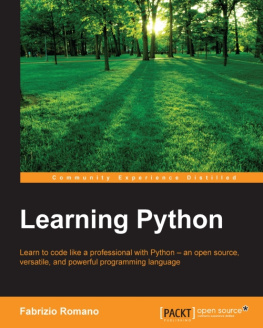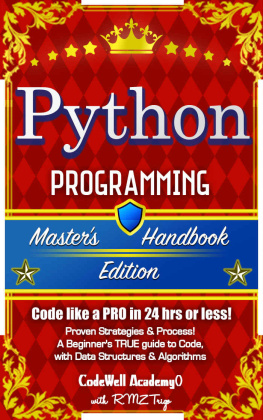Ana Bell - Get programming : learn to code with Python
Here you can read online Ana Bell - Get programming : learn to code with Python full text of the book (entire story) in english for free. Download pdf and epub, get meaning, cover and reviews about this ebook. year: 2018, publisher: Manning Publications, genre: Home and family. Description of the work, (preface) as well as reviews are available. Best literature library LitArk.com created for fans of good reading and offers a wide selection of genres:
Romance novel
Science fiction
Adventure
Detective
Science
History
Home and family
Prose
Art
Politics
Computer
Non-fiction
Religion
Business
Children
Humor
Choose a favorite category and find really read worthwhile books. Enjoy immersion in the world of imagination, feel the emotions of the characters or learn something new for yourself, make an fascinating discovery.
- Book:Get programming : learn to code with Python
- Author:
- Publisher:Manning Publications
- Genre:
- Year:2018
- Rating:3 / 5
- Favourites:Add to favourites
- Your mark:
- 60
- 1
- 2
- 3
- 4
- 5
Get programming : learn to code with Python: summary, description and annotation
We offer to read an annotation, description, summary or preface (depends on what the author of the book "Get programming : learn to code with Python" wrote himself). If you haven't found the necessary information about the book — write in the comments, we will try to find it.
Ana Bell: author's other books
Who wrote Get programming : learn to code with Python? Find out the surname, the name of the author of the book and a list of all author's works by series.
Get programming : learn to code with Python — read online for free the complete book (whole text) full work
Below is the text of the book, divided by pages. System saving the place of the last page read, allows you to conveniently read the book "Get programming : learn to code with Python" online for free, without having to search again every time where you left off. Put a bookmark, and you can go to the page where you finished reading at any time.
Font size:
Interval:
Bookmark:

For online information and ordering of this and other Manning books, please visit www.manning.com. The publisher offers discounts on this book when ordered in quantity. For more information, please contact
Special Sales Department Manning Publications Co. 20 Baldwin Road PO Box 761 Shelter Island, NY 11964 Email: orders@manning.com2018 by Manning Publications Co. All rights reserved.
No part of this publication may be reproduced, stored in a retrieval system, or transmitted, in any form or by means electronic, mechanical, photocopying, or otherwise, without prior written permission of the publisher.
Many of the designations used by manufacturers and sellers to distinguish their products are claimed as trademarks. Where those designations appear in the book, and Manning Publications was aware of a trademark claim, the designations have been printed in initial caps or all caps.
 Recognizing the importance of preserving what has been written, it is Mannings policy to have the books we publish printed on acid-free paper, and we exert our best efforts to that end. Recognizing also our responsibility to conserve the resources of our planet, Manning books are printed on paper that is at least 15 percent recycled and processed without the use of elemental chlorine.
Recognizing the importance of preserving what has been written, it is Mannings policy to have the books we publish printed on acid-free paper, and we exert our best efforts to that end. Recognizing also our responsibility to conserve the resources of our planet, Manning books are printed on paper that is at least 15 percent recycled and processed without the use of elemental chlorine.
 | Manning Publications Co.20 Baldwin RoadPO Box 761Shelter Island, NY 11964 |
ISBN 9781617293788
Printed in the United States of America
1 2 3 4 5 6 7 8 9 10 EBM 23 22 21 20 19 18
To my sons, James and Thomas
I wanted to write this book for two main reasons. I aimed to fill a need for a book that truly taught programming from scratch, and that presented programming as an activity that can help you with daily tasks.
A common misconception people have is that programing has to be a big endeavor every time you do it, where youre trying to write a program that can solve a world problem. But thats not so. Learning to program can improve your day-to-day life! I write short programs all the time, whether its to solve puzzles or to help me make decisions. I wanted to capture this sentiment in this book by making programming as accessible to everyone as I can, showing how with even a little bit of programming knowledge, you can write useful programs customized to your needs.
I teach an introductory Python computer science course for undergraduates. For the most part, many students taking the class have no prior programming experience, in any language. The course is fast-paced, and many students ask if there are any resources online for people who have never programmed before. Almost all the resources I point them to require prior knowledge of programming, which adds another level of indirection to their learning: they have to first grasp the idea of programming and then understand how to apply that to Python. I try not to forget what its like to start learning to program from scratch, no matter how many times I teach the course. I want this book to be a gentle introduction to programming in one of the most popular languages at this time, that also shows how approachable coding can be.
Im so glad I had the opportunity to write this book, so I can help others who are just starting out in the wide world of programming.
First, Id like to thank my husband, CJ. His support throughout the writing of this book was unwavering, from offering suggestions to watching our son while I wrote on weekends.
Next, Id like to thank my parents and sister. My dad taught me programming when I was 12, and Ill never forget how many times he had to explain object-oriented programming to me before it finally clicked. My sister and mom travelled across the country a few times a year to help watch my sons while I got more writing done. My mom, especially, was my secret weapon. She has never programmed before and was the perfect target audience, working through the exercises and reviewing the chapters as I was writing them.
Id also like to thank my development editors at Manning: Kristen Watterson, Dan Maharry, and Elesha Hyde. The book underwent many transformations to become what it is, and I thank them all for their patience while I wrote and rewrote lessons. Their suggestions were much appreciated and made the book that much stronger. A big thanks also goes to my technical development editor, Frances Buontempo, and technical proofreader, Ignacio Beltran Torres, who carefully read the lessons and pointed out corrections and had wonderful suggestions on how to improve the book. Also thanks to everyone else at Manning who helped produce and promote the book. Of course, thank you to all the reviewers who offered their time to read and comment on the book at all stages of development. They are Alexandria Webb, Ana Pop, Andru Estes, Angelo Costa, Ariana Duncan, Artiom Plugachev, Carlie Cornell, David Heller, David Moravec, Adnan Masood, Drew Leon, George Joseph, Gerald Mack, Grace Kacenjar, Ivo Stimac, James Gwaltney, Jeon-Young Kang, Jim Arthur, John Lehto, Joseph M. Morgan, Juston Lantrip, Keith Donaldson, Marci Kenneda, Matt Lemke, Mike Cuddy, Nestor Narvaez, Nicole E. Kogan, Nigel John, Pavol Kr, Potito Colluccelli, Prabhuti Prakash, Randy Coffland, R. Udendhran Mudaliyar, Rob Morrison, Rujiraporn Pitaksalee, Sam Johnson, Shawn Bolan, Sowmy Vajjala-Balakrishna, Steven Parr, Thomas Ballinger, Tom Northwood, Vester Thacker, Warren Rust, Yan Guo, and Yves Dorfsman.
Get Programming: Learn to Code with Python is intended for anyone who is curious about programming but doesnt necessarily want to pursue a career in it. It doesnt assume any programming experience. You should be familiar with the following ideas:
- VariablesReaders who have taken a math course that deals with introductory algebra know what a variable is. This book explains how variables in a programming setting are different.
- Assigning truth values (true/false) to statementsStatements are sentences that can be determined as true or false. For example, It is raining is a statement thats either true or false. You should know how to invert statements to take the opposite truth value by using the word not. For example, if It is raining is true, then It is not raining is false.
- Connecting statementsWhen theres more than one statement, they can be connected by using the words and or or. For example, Its raining and Im happy can become Its raining and Im happy.
- Making decisionsWith multiple statements, you can make a decision based on whether one statement is true by using if...then.... For example, If it is raining then the ground is wet is made up of two statements: It is raining and the ground is wet. The statement the ground is wet is a consequence of the statement it is raining.
- Following instructions by doing any of the following activities or similar
Font size:
Interval:
Bookmark:
Similar books «Get programming : learn to code with Python»
Look at similar books to Get programming : learn to code with Python. We have selected literature similar in name and meaning in the hope of providing readers with more options to find new, interesting, not yet read works.
Discussion, reviews of the book Get programming : learn to code with Python and just readers' own opinions. Leave your comments, write what you think about the work, its meaning or the main characters. Specify what exactly you liked and what you didn't like, and why you think so.

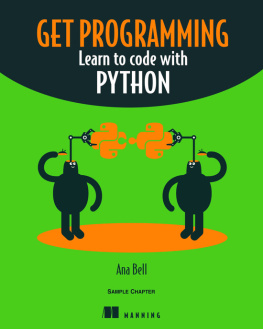
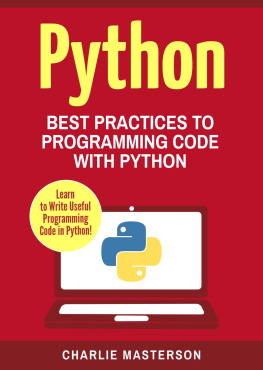

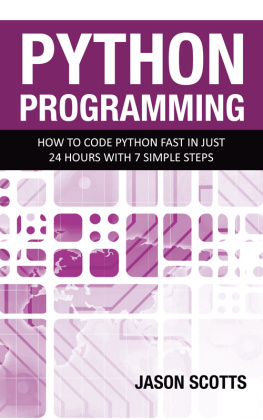
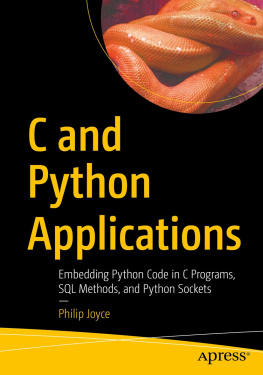
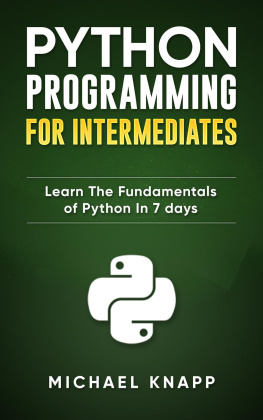
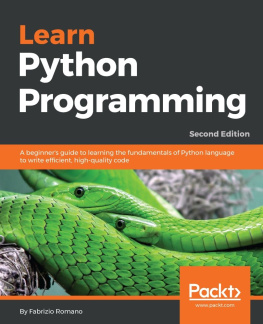
![Paul Gerrard [Paul Gerrard] - Lean Python: Learn Just Enough Python to Build Useful Tools](/uploads/posts/book/124061/thumbs/paul-gerrard-paul-gerrard-lean-python-learn.jpg)
